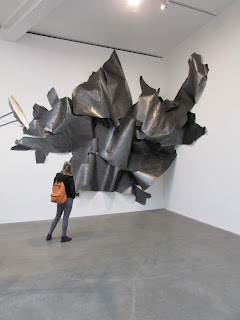Roy Lichtenstein - Frightened Girl, 1964
It wasn't my imagination. I was definately seeing spots before my eyes at this exhibition. I hadn't been back to Lévy Gorvy gallery since the great show they had last year of Pat Steir's Waterfall paintings (here), but I was determined to catch this show of the work of three artists who utilised the Ben-Day dot printing technique to their own ends in their work. The spotty coloured papers I use for my work are produced through a very similar process. The eponymous technique was devised in the 19th century by American illustrator and publisher Benjamin Day as a cost effective printing process that used dots in different densities to reproduce imagery on a mass scale. The technique was refined in the twentieth century and used in the production of newspapers, comic books, and advertisements. This show takes its title from featured artist Gerald Laing's 1964 exhibition at the Slade School of Art - Source and Stimulus. Lichtenstein was the first to adopt the technique of Ben-Day dots in his work in 1961, and then Laing in 1962 with the British half-tone dot system, and lastly Polke in 1963 who manipulated the German Rasterbild dot process. Although the three artists use a very similar technique, the finished results of their work are markedly different. The figurative, representational styles here make for a great contrast and departure from Abstract Expressionism which had been the dominant style of artwork until the 1960s. It was an unexpected surprise to be confronted again so soon with Lichtenstein's Little Aloha, (bottom picture below), which I had encountered only a few weeks earlier in Venice in the Sonnabend Collection at the Ca' Pesaro (here). This exhibition is a rare opportunity to see pieces such as Lichtenstein's Frightened Girl (above), which has been hidden away in a private collection since 1993, and Laing's Raincheck, and Shout, which have not been publicly exhibited since they were created and then bought by a collector in America in 1965. Source and Stimulus: Polke, Lichtenstein, Laing, is another very strong, focused show by the team at Lévy Gorvy.

Roy Lichtenstein - Bread and Jam, 1963
Sigmar Polke - Strand, 1966
Sigmar Polke - Freundinnen (Girlfriends), 1965-66
Roy Lichtenstein
Roy Lichtenstein - VIIP, 1962
Gerald Laing - Lincoln Convertible, 1964
Gerald Laing - C.T. Strokers, 1964
Gerald Laing source materials
Sigmar Polke - Puppe (Doll), 1965
Gerald Laing - Raincheck, 1965
Gerald Laing - Shout, 1965
Sigmar Polke
Gerald Laing - Astronaut II, 1963
Gerald Laing - Starlet I, Starlet II, 1963
Sigmar Polke - Das Par (The Couple), 1965
Sigmar Polke - Frau mit Butterbrot, 1964
Sigmar Polke - Tennisspiel - Tennis Player, 1964
Roy Lichtenstein - Little Aloha, 1962
Source and Stimulus: Polke, Lichtenstein, Laing
until 21st April
Lévy Gorvy
22 Old Bond Street
London
W1
































































